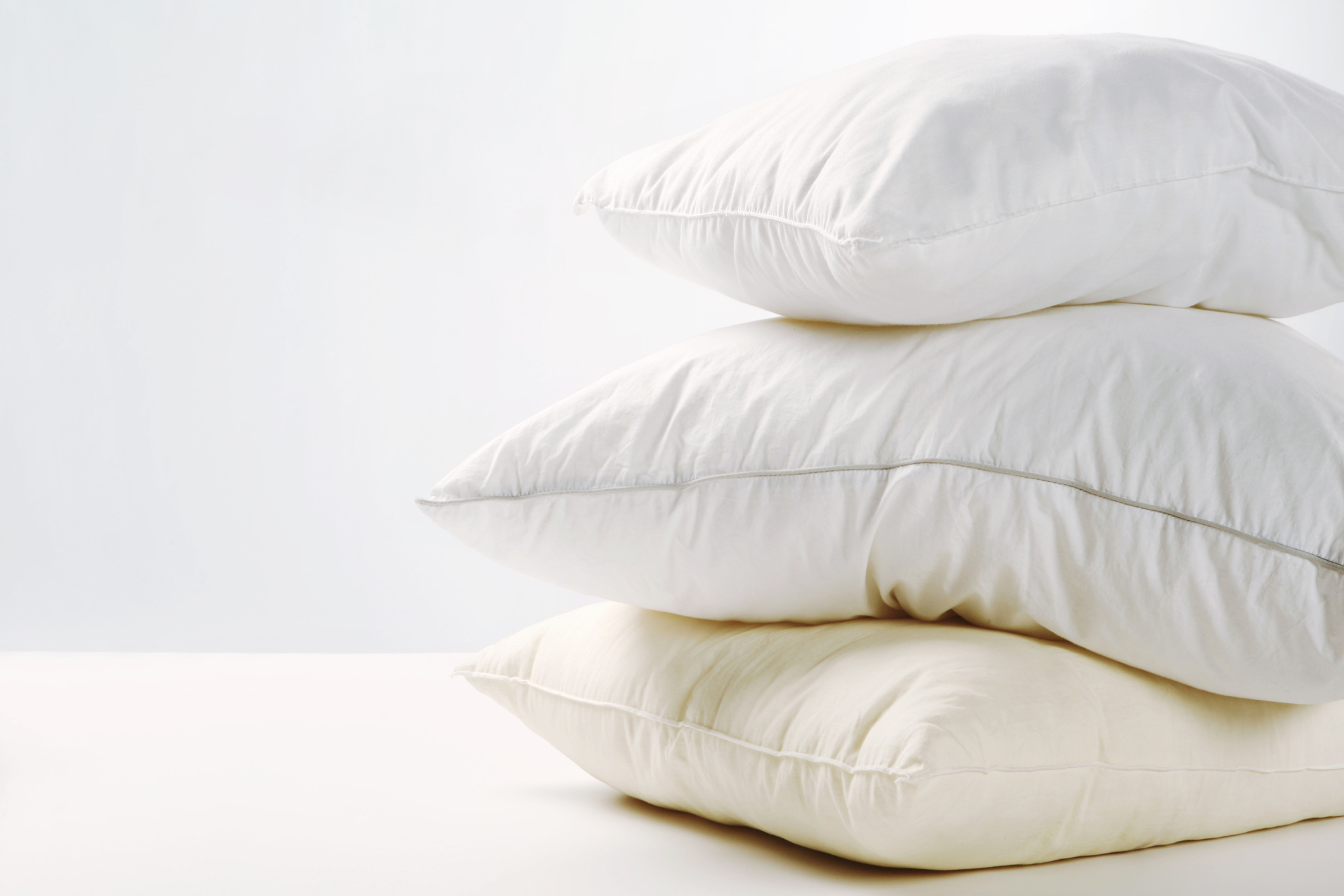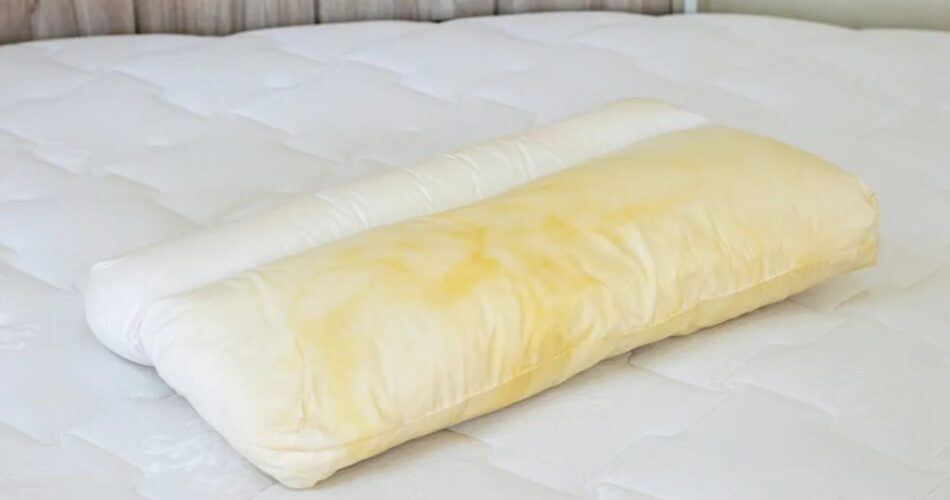Most people notice their once-bright white pillows slowly turning yellow over time. While it may look unpleasant, yellowing is very common. Surveys show that over 70% of households replace pillows every 1–2 years mainly because of discoloration.
But why does this happen, and more importantly, is it safe to sleep on yellow pillows? In this article, we explain the science behind pillow stains, share health facts, and show you how to decide when it’s time to keep or replace your pillow.
- Why Do Pillows Turn Yellow?
- Are Yellow Pillows Healthy to Sleep On?
- How Long Should You Keep a Pillow?
- Signs Your Pillow Is Unhealthy
- Can You Clean Yellow Pillows?
- How Yellow Pillows Affect Sleep Quality
- Preventing Pillows From Turning Yellow
- Cost of Replacing Pillows vs Cleaning
- When to Replace Pillows Immediately
- Conclusion:
Why Do Pillows Turn Yellow?

There are several reasons behind pillow discoloration, most of which are linked to natural body processes and environment.
Key causes include:
- Sweat: The biggest culprit. The human body sweats around 25–50 ml per hour during sleep. Over months, sweat builds up and leaves yellow stains.
- Body Oils: Natural oils from skin and hair seep into the pillow fabric.
- Drool: Saliva stains add to yellowing.
- Skincare and Hair Products: Creams, lotions, or oils transfer to pillows at night.
- Moisture & Humidity: Sleeping in warm rooms accelerates yellowing.
A study by the National Sleep Foundation reports that pillow discoloration can happen in as little as 6 months in humid climates.
Are Yellow Pillows Healthy to Sleep On?

Not all yellow pillows are unsafe, but discoloration can sometimes indicate poor hygiene.
Points to consider:
- Bacteria Growth: Damp pillows can harbor bacteria.
- Dust Mites: An old pillow may contain up to 16 species of fungi and thousands of dust mites, according to Manchester University research.
- Allergies: Stained pillows can trigger sneezing, watery eyes, or skin irritation.
- Odor: Yellowing combined with musty smells may indicate mold.
If your pillow looks yellow but smells fresh and feels supportive, it may still be safe. If it smells bad or causes allergy symptoms, it’s time to replace it.
How Long Should You Keep a Pillow?

Experts recommend replacing pillows every 1–2 years depending on material and usage.
Pillow Lifespan Estimates
| Pillow Material | Average Lifespan | Notes |
|---|---|---|
| Feather/Down | 18–24 months | Needs fluffing often |
| Memory Foam | 24–36 months | Holds shape longer |
| Polyester | 12–18 months | Cheapest but wears quickly |
| Latex | 24–48 months | Naturally resistant to mold |
| Bamboo/Hybrid | 18–36 months | Eco-friendly but needs care |
A 2023 bedding industry survey found that 41% of sleepers use pillows older than 2 years, even though most are past their healthy lifespan.
Signs Your Pillow Is Unhealthy
You can do a simple pillow health check at home.
Watch out for:
- Visible yellow or brown stains spreading across the pillow.
- Musty, sour, or sweaty odors.
- Lumps or loss of firmness.
- Neck pain when you wake up.
- Sneezing or itchy eyes after sleeping.
Quick Test: Fold your pillow in half and let go. If it stays folded instead of springing back, it’s time to replace it.
Can You Clean Yellow Pillows?

Yes, many yellow pillows can be cleaned and restored.
Cleaning Tips:
- Machine Wash: Most polyester and cotton pillows are machine-washable. Use hot water and mild detergent.
- Whitening Solution: Add half a cup of baking soda or white vinegar to remove stains.
- Sunlight: Drying pillows in direct sunlight helps kill bacteria and bleach stains naturally.
- Pillow Protectors: Using zippered protectors reduces staining by up to 50%, according to sleep product reviews.
However, if your pillow smells bad even after washing or feels lumpy, cleaning won’t help it’s time to replace it.
How Yellow Pillows Affect Sleep Quality
Your pillow is as important as your mattress for healthy sleep. Poor pillow hygiene can disturb your rest.
Facts:
- Dust mites in pillows are a leading cause of night-time allergies affecting up to 30% of adults.
- Old pillows lose shape, leading to neck and back pain.
- A study in Journal of Chiropractic Medicine showed that people who changed pillows reported 21% better sleep quality within a week.
Preventing Pillows From Turning Yellow
While you cannot stop yellowing completely, you can slow it down.
Prevention tips:
- Always use pillow protectors under pillowcases.
- Wash pillowcases every week.
- Keep hair dry before bed.
- Avoid heavy skincare products at night.
- Air pillows in sunlight once a month.
These steps can extend pillow lifespan by 6–12 months.
Cost of Replacing Pillows vs Cleaning
Many people hesitate to buy new pillows due to cost.
| Option | Average Cost | Lifespan/Effectiveness |
|---|---|---|
| Cleaning with DIY methods | $2–$5 per wash | Works for mild stains |
| Buying new polyester pillow | $15–$30 | 1–1.5 years |
| Buying new memory foam pillow | $50–$100 | 2–3 years |
| Buying luxury down pillow | $100–$200 | 2 years with care |
Replacing pillows regularly is actually cost-effective compared to long term health issues like allergies or poor sleep.
When to Replace Pillows Immediately
Some situations demand urgent replacement:
- If pillow smells musty even after washing.
- If you wake up with congestion or headaches.
- If pillow has visible mold spots.
- If pillow no longer supports your head.
Sleeping on unhealthy pillows can increase risk of asthma attacks, skin breakouts, and poor sleep cycles.
Conclusion:
Yellow pillows are a natural part of life, but they are also a warning sign. While sweat and body oils cause discoloration, prolonged stains may point to poor hygiene or old age. Experts agree that pillow replacement every 1–2 years is the best way to maintain healthy sleep.
You can wash and protect pillows to extend their life, but when in doubt replace them. A clean, supportive pillow not only improves your sleep but also protects your health.

